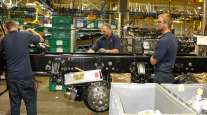OEMs Eke Out 2016 Profits; European Sales Strongest

This story appears in the Feb. 6 print edition of Transport Topics.
Three of the world’s largest heavy-duty truck makers remained profitable in an anemic 2016, with fourth-quarter results revealing that European sales outpaced the North American market.
Original equipment manufacturer Volvo AB reported a fourth quarter of improving revenue and net income, compared with dips for both measurements on an annual basis.
Europe and Asia were the truck markets that provided the Gothenburg, Sweden-based OEM the most growth as North American activity continued to decline “but with some signs of stabilization.”
As a whole, the corporation earned the equivalent of $534.5 million, or 26.2 cents a share. In the 2015 fourth quarter, the company had net income of $305.5 million, or 14.9 cents. Quarterly revenue rose in Swedish kronor but declined in dollars because of the exchange rate shift, to $9.13 billion from $9.37 billion.
Global truck making — including Volvo and Mack Trucks in North America — produces a majority of the company’s revenue and a strong majority of its operating profits. Volvo’s other major divisions are construction equipment, marine engines, buses and financial services.
CEO Martin Lundstedt noted the importance of improved profit margins even if sales volumes did not boom. The truck division’s operating margin rose to 8.8% from 7.8% in the 2015 fourth quarter.
For the global truck division, quarterly operating income rose to the equivalent of $533.7 million from $507.1 million for the final three months of 2015, even as revenue declined over the same time to $6.03 billion from 6.48 billion.
“The North American heavy-duty truck industry continued in a correction mode in Q4, with low production in response to reduced demand and elevated inventories of new and used trucks,” the report said.
“Virtually the entire decline was registered in the highway tractor segments,” Volvo said.
Volvo is maintaining its North American heavy-duty, new registration forecast for this year at 215,000 vehicles, down from 243,229 in 2016 and 301,740 in 2015.
“The European trucks business is booming,” German stock analyst Hans-Peter Wodniok of Fairesearch GmbH told Bloomberg News after Volvo reported. “The negative drag in the North American truck market is slowing while construction equipment is ticking up.”
Daimler AG had a strongly profitable fourth quarter to top off a year of modest improvements, but the growth came from the sale of Mercedes-Benz cars and buses, while the truck division reported double-digit contractions in operating profit and revenue for both the quarter and the year.
In the most recent quarter, Daimler Trucks earned the equivalent of $374.4 million on revenue of $9.13 billion. In the 2015 fourth quarter, the division had an operating profit of $690.9 million on revenue of $11.03 billion.
Quarterly operating margin for truck making declined to 4.1% from 6.3%.
“The negative development of earnings was primarily the result of sharply decreased unit sales in the Nafta region, Turkey, the Middle East, Latin America and Indonesia. Earnings were also reduced by intense competition in Europe,” the company said of its truck division in a Feb. 2 earnings statement.
For all of Stuttgart, Germany- based Daimler, the company earned the equivalent of $2.38 billion, or $2.17 a share, on quarterly revenue of $44.24 billion. In the 2015 fourth quarter, the company had net income of $2.05 billion, or $1.85, on revenue of $44.27 billion.
Management expects truck sales this year will be fairly similar to those in 2016, with the second half of the year better than the first six months.
Daimler Trucks’ global investment was $1.33 billion in 2016, up from $1.22 billion the year before, the company said.
Revenue and net income declined at Paccar Inc. for both the fourth quarter and the year, but the Bellevue, Washington-based corporation did remain profitable in both periods.
Paccar, the parent of Kenworth Truck Co. and Peterbilt Motors Co., earned $288.8 million, or 82 cents a share, on quarterly revenue of $3.77 billion. In the fourth quarter of 2015, it had net income of $347.2 million, or 98 cents, on revenue of $4.06 billion.
“Paccar’s financial results reflect the company’s premium-quality products and services, increased European truck deliveries, higher truck market share, and good aftermarket parts and Paccar Financial Services results,” CEO Ron Armstrong said in the company’s Jan. 31 earnings release.
Paccar management expects 2016 conditions probably will extend into this year. Heavy- duty U.S.-Canadian sales were 216,000 last year, industrywide, and are expected to be in the range of 190,000 to 220,000 vehicles this year. Sales in 2015 were 278,000 units, the company said.
The United States and Canada is the largest market for Paccar. Quarterly revenue there fell by 10.6% to $2.2 billion, and truck deliveries declined by 9.4% to 14,400.
Annual results fell precipitously because of a second-quarter settlement with the European Commission on price fixing, an investigation that affected several truck OEMs, in addition to DAF Trucks. The settlement amount was $833 million.



